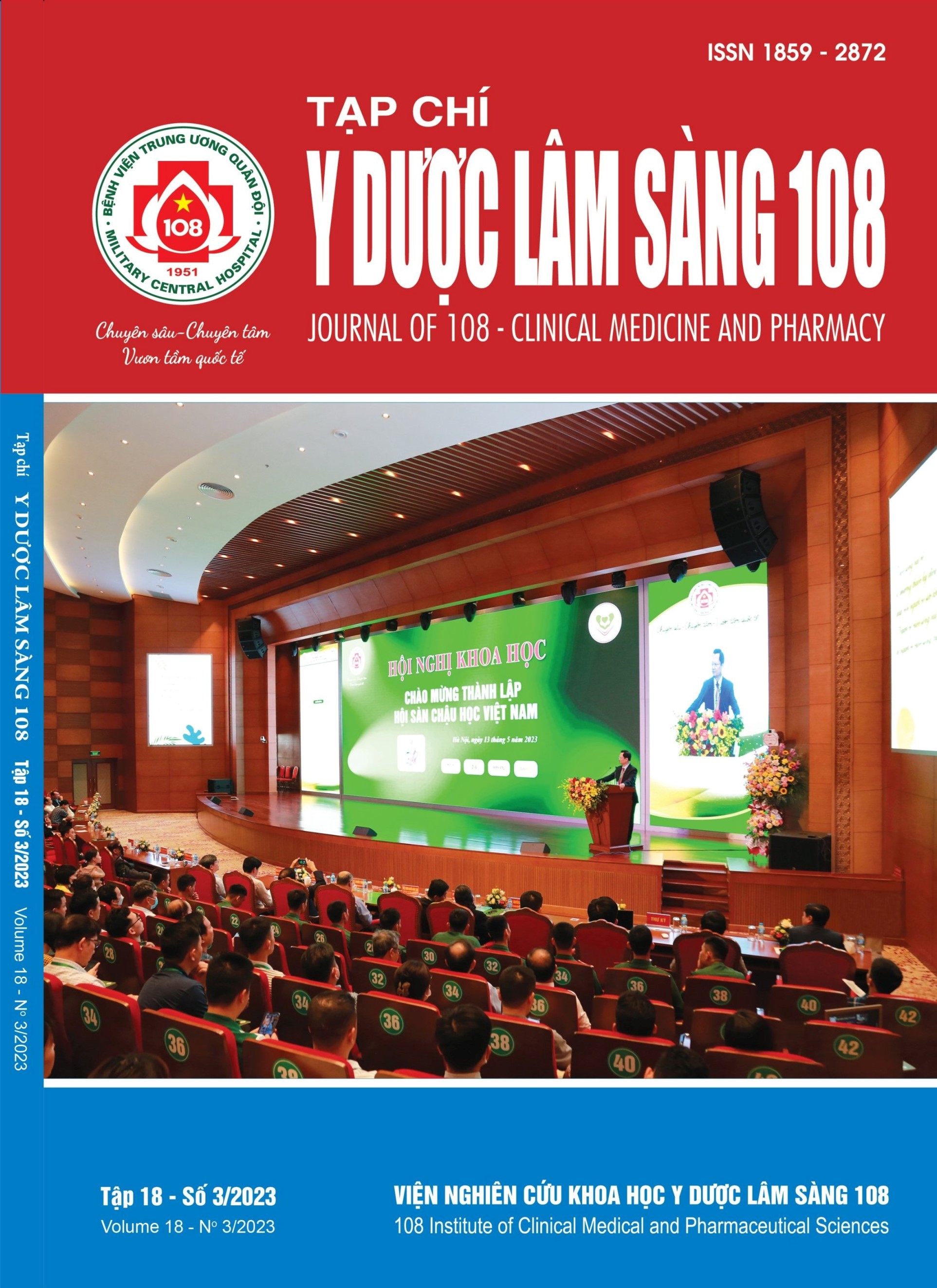Liên quan giữa nồng độ kẽm huyết tương với bệnh cảnh lâm sàng ở bệnh nhân nhiễm khuẩn huyết
Main Article Content
Keywords
Tóm tắt
Mục tiêu: Mô tả biến đổi nồng độ kẽm (Zn) huyết tương và tìm hiểu mối liên quan giữa nồng độ Zn huyết tương với bệnh cảnh lâm sàng ở bệnh nhân (BN) nhiễm khuẩn huyết (NKH). Đối tượng và phương pháp: Nghiên cứu tiến cứu mô tả được tiến hành trên 125 BN NKH điều trị tại Bệnh viện TWQĐ 108 từ tháng 11/2019 đến tháng 02/2021. Đo nồng độ Zn huyết tương tại thời điểm vào viện (Zn1) và tại thời điểm ngày 3 (Zn3) sau vào viện, ghi nhận sống sót và tử vong (TV) 30 ngày. Kết quả: Tỷ lệ thiếu Zn1 là 72,8%. Nồng độ Zn1 là 54,0 (37,15-74,4) µg/dL, nồng độ Zn3 là 68,7 (55,3-89,2) µg/dL, sự khác biệt có ý nghĩa thống kê p<0,001. Nhóm có điểm SOFA < 7 điểm có nồng độ Zn1 cao hơn nhóm có điểm SOFA ≥ 7 điểm, p<0,01. Nồng độ Zn1 huyết tương giữa nhóm sốc và nhóm không sốc, giữa nhóm thở máy và nhóm không thở máy, giữa nhóm suy thận và không suy thận, giữa nhóm suy gan và không suy gan, giữa nhóm sống và nhóm TV 30 ngày không có sự khác biệt. Kết luận: Thiếu Zn1 thường gặp ở BN NKH. Nồng độ Zn1 thấp hơn Zn3. Nhóm có điểm SOFA cao hơn có nồng độ Zn1 thấp hơn. Nồng độ Zn1 giữa nhóm sống và nhóm TV 30 ngày không có sự khác biệt.
Article Details
Các tài liệu tham khảo
2. Belsky JB, Wira CR, Jacob V et al (2018) A review of micronutrients in sepsis: the role of thiamine, l-carnitine, vitamin C, selenium and vitamin D. Nutrition Research Reviews 31(2): 281-290.
3. Alker W, Haase H (2018) Zinc and sepsis. Nutrients 10(8).
4. Singer M, Deutschman CS, Seymour CW, Shankar-Hari M, Annane D, Bauer M, Bellomo R, Bernard GR, Chiche JD, Coopersmith CM, Hotchkiss RS, Levy MM, Marshall JC, Martin GS, Opal SM, Rubenfeld GD, van der Poll T, Vincent JL, Angus DC (2016) The third international consensus definitions for sepsis and septic shock (sepsis-3). JAMA 315(8): 801-810.
5. Ayoglu H, Sezer U, Akin M et al (2016) Selenium, copper, zinc, iron levels and mortality in patients with sepsis and systemic inflammatory response syndrome in Western Black Sea Region, Turkey. J Pak Med Assoc 66(4): 447-452.
6. Gaetke LM, McClain CJ, Talwalkar RT et al (1997) Effects of endotoxin on zinc metabolism in human volunteers. Am J Physiol 272(6-1): 952-956.
7. Liuzzi JP, Lichten LA, Rivera S et al (2005) Interleukin-6 regulates the zinc transporter Zip14 in liver and contributes to the hypozincemia of the acute-phase response. Proc Natl Acad Sci U S A 102 (19): 6843-6848.
8. Lichten LA, Liuzzi JP, Cousins RJ (2009) Interleukin-1beta contributes via nitric oxide to the upregulation and functional activity of the zinc transporter Zip14 (Slc39a14) in murine hepatocytes. Am J Physiol Gastrointest Liver Physiol 296(4): 860-867.
9. Moshage H (1997) Cytokines and the hepatic acute phase response. J Pathol 181(3): 257-266.
10. Zhou Z, Wang L, Song Z et al (2004) Abrogation of nuclear factor-kappaB activation is involved in zinc inhibition of lipopolysaccharide-induced tumor necrosis factor-alpha production and liver injury. Am J Pathol 164(5): 1547-1556.
11. Besecker BY, Exline MC, Hollyfield J et al (2011) A comparison of zinc metabolism, inflammation, and disease severity in critically ill infected and noninfected adults early after intensive care unit admission. Am J Clin Nutr 93(6): 1356-1364.
12. Hoeger J, Simon TP, Beeker T et al (2017) Persistent low serum zinc is associated with recurrent sepsis in critically ill patients - A pilot study. PLoS One 12(5): 0176069.
13. Van Nhien N, Khan NC, Yabutani T et al (2006) Serum levels of trace elements and iron-deficiency anemia in adult Vietnamese. Biol Trace Elem Res 111(1-3): 1-9.
14. Laillou A, Pham TV, Tran NT et al (2012) Micronutrient deficits are still public health issues among women and young children in Vietnam. PLoS One 7(4): 34906.
15. Yildiz H (2019) Is it given over importance to serum zinc level in patients with sepsis? Zinc and sepsis. Progress in Nutrition 21(3): 605-610.
16. Shankar AH, Prasad AS (1998) Zinc and immune function: The biological basis of altered resistance to infection. Am J Clin Nutr 68(2): 447-463.
17. Cander B, Dundar ZD, Gul M et al (2011) Prognostic value of serum zinc levels in critically ill patients. J Crit Care 26(1): 42-46.
18. Visalakshy J, Visalakshy J, Surendran S et al (2017) Could plasma zinc be a predictor for mortality and severity in sepsis syndrome? International Journal of Research in Medical Sciences 5(9): 3929-3934.
19. Saleh NY, Abo El Fotoh WMM (2018) Low serum zinc level: The relationship with severe pneumonia and survival in critically ill children. Int J Clin Pract 72(6): 13211.
20. Avinash A, Kumar A, Manish G et al (2018) Trace Elements and Sepsis: Is there a Correlation? International Journal of Medicine and Public Health 8: 133-139.
 ISSN: 1859 - 2872
ISSN: 1859 - 2872
